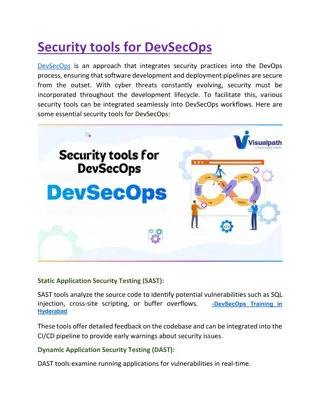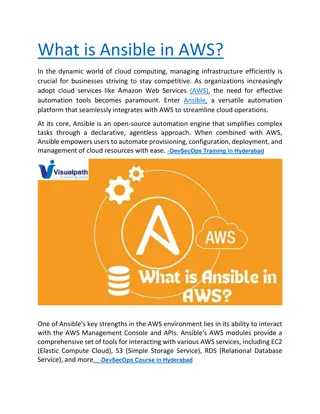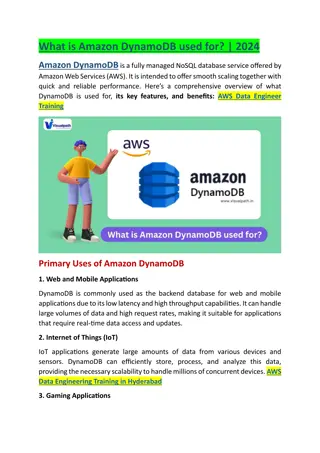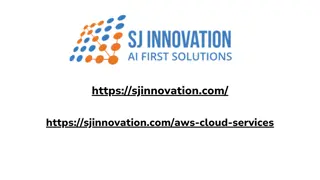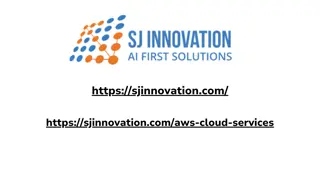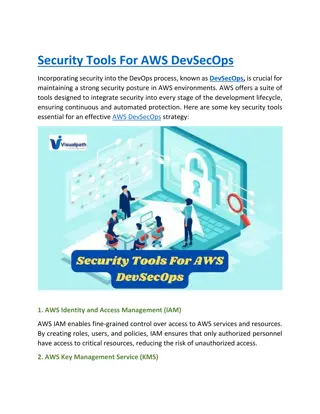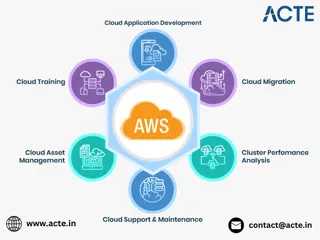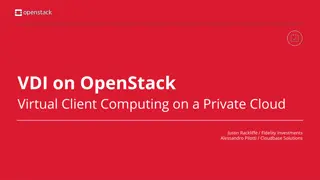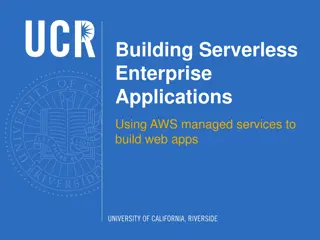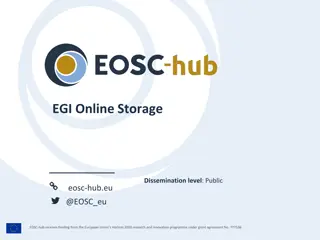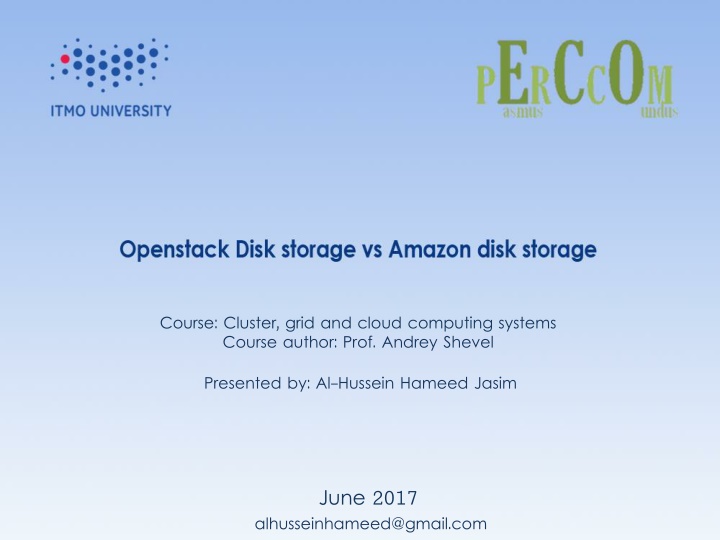
Understanding Block and Object Storage in Cloud Computing Systems
Learn about block and object storage in cloud computing, including the differences, use cases, and examples of OpenStack and AWS storage solutions. Explore the concepts of private, public, and hybrid cloud storage to enhance your understanding of cloud computing platforms.
Download Presentation

Please find below an Image/Link to download the presentation.
The content on the website is provided AS IS for your information and personal use only. It may not be sold, licensed, or shared on other websites without obtaining consent from the author. If you encounter any issues during the download, it is possible that the publisher has removed the file from their server.
You are allowed to download the files provided on this website for personal or commercial use, subject to the condition that they are used lawfully. All files are the property of their respective owners.
The content on the website is provided AS IS for your information and personal use only. It may not be sold, licensed, or shared on other websites without obtaining consent from the author.
E N D
Presentation Transcript
Course: Cluster, grid and cloud computing systems Course author: Prof. Andrey Shevel Presented by: Al-Hussein Hameed Jasim June 2017 alhusseinhameed@gmail.com
Introduction OpenStack is a set of software tools for building and managing cloud computing platforms for public and private clouds. Amazon Web Services (AWS) offers a broad set of global compute, storage, database, analytics, application, and deployment services. Help organizations move faster, lower IT costs, and scale applications. Private cloud storage Private cloud storage is exactly what the name says. Designed for one person or company that is specific to customer s needs. Public cloud storage Based on the standard cloud computing model. Service provider makes resources available to the general public over the Internet. Hybrid Cloud Storage Hybrid clouds offer a combination of private and public clouds. Customization of the features and insert the applications that meet customer s needs. 2
Block and Object storages Block storage Block storage is more like the hard drive in the computer in use and function and is typically used to provide virtual machines with an attached storage volume (virtual hard drive) Snapshots and backups of virtual servers. Good examples for block storage use cases are structured database storage, random read/write loads, and virtual machine file system (VMFS) volumes. Object storage Static Web content, data backups and archival images, and multimedia (videos, pictures, or music) files are best stored as objects. It has its own API and support other APIs as well. Every object contains three things: 1- The data itself, photo, document, etc. 2- An expandable amount of metadata. Defined by whoever creates the object storage. 3- A globally unique identifier. An address given to the object in order for the object to be found over a distributed system. 3
Block storage VS Object storage Block storage Add persistent storage to a VM Operating system kernel Within a VM Cinder Deleted by user Specified by user in initial request 1 TB disk Object storage Store data Use Accessed through REST API Accessible from Managed by Persists until Sizing determined by Anywhere via HTTP(S) Swift Deleted by user Amount of available physical storage 10s of TBs of dataset storage Example of typical usage 5
OpenStack storage and AWS storage OpenStack AWS Type of the storage Block storage Create virtual disk drives (volumes). Object storage Store files: media, documents, images etc Cinder S3 Swift EC2 6
Block storage in OpenStack Cinder is a Block Storage service for OpenStack. The Cinder interface provides a number of standard functions such as create volume, delete volume and attach volume . Cinder volumes provide persistent storage to guest virtual machines (known as instances) that are managed by OpenStack Compute software. Delivered using standard protocols such as iSCSI. It uses Fibre channel, NFS or a range of other proprietary. Synchronous replication used to provide a high level of availability. Vendors: HP, IBM, Hitachi data systems. Disadvantage: Durability issues 7
Object storage in OpenStack Swift is a scalable redundant storage system. Objects are stored and retrieved from Swift using simple commands such as PUT or GET, based on the HTTP protocol, also known as a RESTful API. A ring represents components that deliver the Swift service Data resiliency is managed within Swift using the concept of zones. Swift uses the idea of eventual consistency to implement data resiliency. (more risky) The downside to eventual consistency is that there is no guarantee that a read request returns the most recent version of the data. 8
Block storage in AWS Amazon Elastic Compute Cloud (Amazon EC2) is a web service that provides resizable compute capacity in the cloud. It is designed to make web-scale cloud computing easier for developers. Virtual computing environments, known as instances. Preconfigured templates for your instances, known as Amazon Machine Images (AMIs). Secure login information for your instances using key pairs. Multiple physical locations for your resources, such as instances and Amazon EBS volumes, known as regions and Availability Zones. Pricing: We need to create a 20GB volume to hold the 10GB file, because resizing disks is not a painless operation. We have to pay for the full size of the EBS volume (20GB) rather than just the file itself. EBS costs $0.05/GB/month, so $1.00/month in EBS storage. 9
Object storage in AWS Amazon Simple Storage Service (Amazon S3) is object storage with a simple web service interface to store and retrieve any amount of data from anywhere on the web. Customers use S3 as primary storage for cloud-native applications; as a bulk repository, or "data lake," for analytics Also offers the Standard-Infrequent Access tier, which has the same durability but at a reduced cost with a 30-day storage minimum. This is ideal for less active data that needs immediate access. Once data is stored in S3, it can be automatically tiered into lower cost, longer-term cloud storage classes like S3 Standard - Infrequent Access and Amazon Glacier for archiving. Object store S3 is distributed, replicated and highly available data store designed for large volume of data sharing. Pricing: To store file of 10 GB, Standard S3 costs USD $0.03/GB/month. The cost is 30 cents/month. 10
Recommendations In making the decision to use a particular platform, system architects need to weigh the risks vs. the cost of using OpenStack free solutions (that still need hardware) or benefiting from features offered within dedicated hardware. It s better to avoid using object storage for transactional data, especially because of the eventual consistency model outlined previously. As Swift uses the HTTP protocol, it would be perfectly practical to use third-party storage solutions for object storage within OpenStack. OpenStack implementations are usually built around scale-out server configurations, so Fibre Channel is not the best choice of protocol. It s not recommend you use object storage for transactional data, especially because of the eventual consistency model outlined previously. 11
URLs 1-http://www.cloudstoragebest.com/cloud-storage-types/ 2-https://opensource.com/resources/what-is-openstack 3- https://www.druva.com/blog/object-storage-versus-block-storage- understanding-technology-differences/ 4- http://searchcloudstorage.techtarget.com/essentialguide/Working-with- OpenStack-storage-Tips-on-Cinder-Swift-and-the-cloud 5- https://www.druva.com/blog/object-storage-versus-block-storage- understanding-technology-differences/ 12





